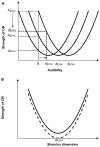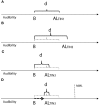An adaptation level theory of tinnitus audibility
- PMID: 22707935
- PMCID: PMC3374480
- DOI: 10.3389/fnsys.2012.00046
An adaptation level theory of tinnitus audibility
Abstract
Models of tinnitus suggest roles for auditory, attention, and emotional networks in tinnitus perception. A model of tinnitus audibility based on Helson's (1964) adaptation level theory (ALT) is hypothesized to explain the relationship between tinnitus audibility, personality, memory, and attention. This theory attempts to describe how tinnitus audibility or detectability might change with experience and context. The basis of ALT and potential role of auditory scene analysis in tinnitus perception are discussed. The proposed psychoacoustic model lends itself to incorporation into existing neurophysiological models of tinnitus perception. It is hoped that the ALT hypothesis will allow for greater empirical investigation of factors influencing tinnitus perception, such as attention and tinnitus sound therapies.
Keywords: adaptation level; model; tinnitus; treatment.
Figures


Similar articles
-
Examining the short term effects of emotion under an Adaptation Level Theory model of tinnitus perception.Hear Res. 2017 Mar;345:23-29. doi: 10.1016/j.heares.2016.12.013. Epub 2016 Dec 25. Hear Res. 2017. PMID: 28027920
-
Final common pathway for tinnitus: theoretical and clinical implications of neuroanatomical substrates.Int Tinnitus J. 2009;15(1):5-50. Int Tinnitus J. 2009. PMID: 19842346 Review.
-
Illusory percepts from auditory adaptation.J Acoust Soc Am. 2007 Mar;121(3):1632-41. doi: 10.1121/1.2431346. J Acoust Soc Am. 2007. PMID: 17407900
-
Tinnitus what and where: an ecological framework.Front Neurol. 2014 Dec 15;5:271. doi: 10.3389/fneur.2014.00271. eCollection 2014. Front Neurol. 2014. PMID: 25566177 Free PMC article. Review.
-
Theoretical Tinnitus Framework: A Neurofunctional Model.Front Neurosci. 2016 Aug 19;10:370. doi: 10.3389/fnins.2016.00370. eCollection 2016. Front Neurosci. 2016. PMID: 27594822 Free PMC article.
Cited by
-
Comparison of Different Therapeutic Effects of T-MIST for Chronic Idiopathic Tinnitus.Biomed Res Int. 2022 Sep 29;2022:9236822. doi: 10.1155/2022/9236822. eCollection 2022. Biomed Res Int. 2022. PMID: 36212710 Free PMC article.
-
The neuroscience of tinnitus: understanding abnormal and normal auditory perception.Front Syst Neurosci. 2012 Jul 11;6:53. doi: 10.3389/fnsys.2012.00053. eCollection 2012. Front Syst Neurosci. 2012. PMID: 22798948 Free PMC article. No abstract available.
-
A randomized single-blind controlled trial of a prototype digital polytherapeutic for tinnitus.Front Neurol. 2022 Aug 5;13:958730. doi: 10.3389/fneur.2022.958730. eCollection 2022. Front Neurol. 2022. PMID: 35989940 Free PMC article.
-
A Mixed-Methods Trial of Broad Band Noise and Nature Sounds for Tinnitus Therapy: Group and Individual Responses Modeled under the Adaptation Level Theory of Tinnitus.Front Aging Neurosci. 2017 Mar 9;9:44. doi: 10.3389/fnagi.2017.00044. eCollection 2017. Front Aging Neurosci. 2017. PMID: 28337139 Free PMC article.
-
Behavioral Outcomes and Neural Network Modeling of a Novel, Putative, Recategorization Sound Therapy.Brain Sci. 2021 Apr 27;11(5):554. doi: 10.3390/brainsci11050554. Brain Sci. 2021. PMID: 33925762 Free PMC article.
References
-
- Andersson G., Eriksson J., Lundh L. G., Lyttkens L. (2000). Tinnitus and cognitive interference: a Stroop paradigm study. J. Speech Lang. Hear. Res. 43, 1168–1173. - PubMed
-
- Baracca G., Del Bo L., Ambrosetti U. (2011). “Tinnitus and hearing loss,” in Textbook of Tinnitus, eds Møller A. R., Langguth B., De Ridder D., Kleinjung T. (New York: Springer; ), 285–291.
-
- Baskill J. L., Coles R. R. A. (1999). “Relationship between tinnitus loudness and severity,” in Sixth International Tinnitus Seminar, ed. Hazell J. (London: The Tinnitus and Hyperacusis Centre), 424–428.
Grants and funding
LinkOut - more resources
Full Text Sources
Other Literature Sources

